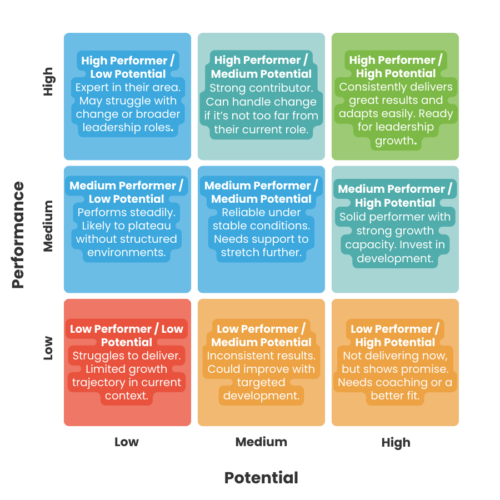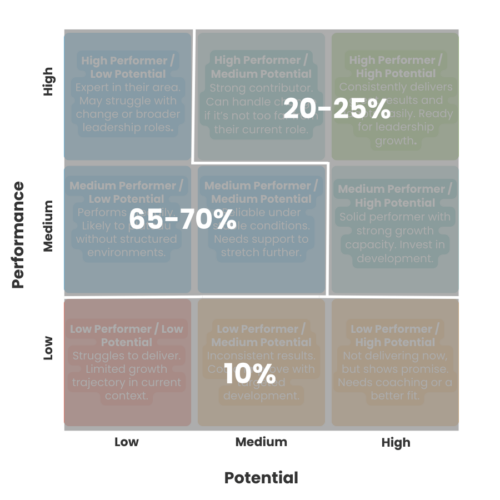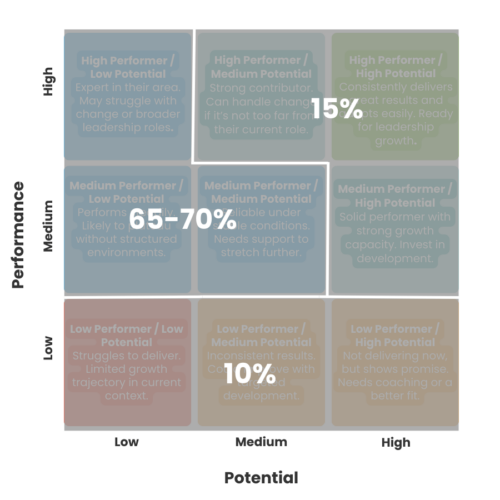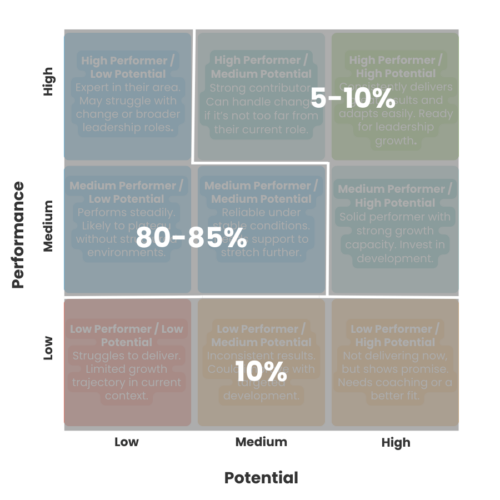If you’re responsible for HR in a mid-sized, growing company, you’re probably facing some challenges with identifying the talent in your business.
The 9 box talent grid has become one of the most widely adopted tools for assessing talent. It plots employees along two axes—performance and potential—to guide succession planning and leadership development.
But here’s the catch: what the 9 box actually tells you is often misunderstood, misused, or misapplied.
So if you’re a business leader or HR decision-maker relying on the grid for your talent decisions, it’s worth asking:
Is your 9 box helping you build future leaders—or just making your current employees feel boxed in?
What is the 9 box talent grid?
At its simplest, the 9 box grid is a matrix used in talent reviews to categorise employees by:
Performance: How consistently someone delivers results in their current role.
Potential: Often linked to learning agility, this shows how quickly someone can take on more complex work.
Each of the nine cells offers insight into how an individual might be developed, supported, or moved within the organisation. But the real power of the 9 box grid lies in what it tells you about your organisation’s leadership supply and demand.

Understanding the 9 box talent grid: Performance vs Potential
How to use a 9 box grid strategically
When used well, the 9 box grid is more than a talent snapshot—it’s a leadership forecasting tool.
Imagine your business is entering a rapid growth phase. If your current leadership talent doesn’t match that trajectory, you risk creating a leadership vacuum—where roles are filled by people who aren’t yet ready. On the flip side, over-developing leaders in a stagnant or declining market can lead to frustration, attrition, and wasted investment.
The grid allows you to shift your development focus based on your business environment.

9 Box talent grid with recommended talent distribution for rapid growth

9 Box talent grid with recommended leadership distribution for stable growth

9 Box talent grid with recommended leadership talent distribution during negative growth
In periods of high growth or uncertainty:
Aim to have 20–25% of your talent in the top-right boxes (high performance, high potential), and 65–70% in the middle tiers.
In stable, predictable environments:
Adjust your strategy to 15% high potential, 75% medium potential, and the rest in lower-demand development zones.
In negative growth or contraction phases:
Scale back to 5–10% high potential talent, with the majority in medium potential areas to avoid over-development and stagnation.
These percentages aren’t just theoretical—they help you align leadership development to business cycles and prevent talent mismatches across regions, divisions, or functions.
| Business Condition | Recommended % in “High Potential” | Why It Matters |
|---|---|---|
| Rapid Growth | 20–25% | You need to scale leadership capacity quickly. |
| Stable/Predictable | 15% | Keep your bench strong, but don’t over-invest. |
| Contraction/Decline | 5–10% | Too many high potentials = flight risk. |
The hidden bias of the 9 box talent grid
One of the biggest misunderstandings we see companies make in their talent reviews, is treating promotability and potential as the same. They’re not.
High potential doesn’t mean promotability
Promotability = readiness to step into a new role now.
Potential = capacity to grow into larger roles over time.
Someone might be highly promotable today but have limited upward potential. Others might not be ready yet, but could become future leaders if developed intentionally. The 9 box talent grid helps you see the difference—and avoid over-promoting or overlooking key talent.
The opposite of high potential is not low potential
What happens to individuals in the top left block? Being labelled High Performer, Low Potential feels a lot like saying: “Thanks for all your hard work, but we don’t see a future for you here.”
The opposite of high potential is not low potential, but rather, high professional. And these employees are highly valuable to your business:
- They’re not racing to the top
- They’re gaining deep expertise, building long-term internal and external relationships and accumulating institutional knowledge.
High performers with low potential may lack the learning agility or desire to take on broader, more complex roles, but they are critical to your business operations.
You need both high potentials and high professionals. But the 9 box rarely celebrates the second group.
Why use a 9-box grid in your talent reviews?
Used properly, a 9 box grid helps your team:
Align leadership pipelines with business strategy
Focus development spend where it matters
Identify high performers who aren’t on a leadership track—but are critical to the business (a group often overlooked)
Build succession plans with confidence.
However, if your 9 box talent review ends in a meeting with no follow-up action—your grid isn’t a talent strategy, it’s a spreadsheet.
To move from a tick-box to outcomes, your 9-box needs a clear link to your business strategy.
At Peopletree Group, we integrate the 9 box into a broader talent strategy framework—using it as a stepping stone, not the destination.
At Peopletree Group, we make the 9-box work for you
You need six capabilities to implement a talent review process that actually drives results:
Talent process design – A talent process that aligns your talent grid to your business needs
Technology and applications – A platform that simplifies the collection and identification of your talent
Data design and management – Data that helps you reliably differentiate performance and potential
Data Visualisation – Interactive dashboards and insights that help execs and managers maximise the value of talent
Project implementation – Resources that can help you implement the plan on time and within budget
Change management – Embedding the process and ensuring buy-in from managers and employees.
Peopletree Group provides all 6 capabilities at a fraction of the cost of hiring or contracting these skills internally. If you’re looking to launch a new talent review process, or need to revamp your talent strategy to grow your business, chat to us about our composable solutions.
Ready to align your people and profit?
Use the 9-Box to Maximise Your Talent
✔️ Identify your true high potentials
✔️ Retain high professionals
✔️ Plan for succession with confidence
✔️ Align people with profit—at every stage of growth
You have great talent in your business. Now it's time to reveal them.
Book a Free 15-Minute Call






